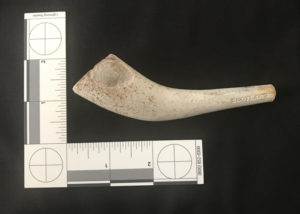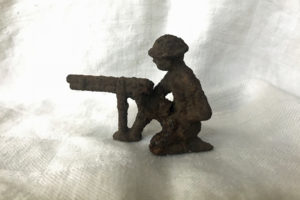True Tales from Canton’s Past: Trash & Treasure
By George T. ComeauLinda Little has fond memories of her grandfather Leland’s home in Washington state. Looking back upon her time with him, she now knows what rooted her curiosity in archeology. “He had a room in the back of his house; it was a little museum,” Linda recalled. The room, filled with shelves and glass cases, held all the curiosities that Leland Lancaster had collected and dug up. There were cases filled with rocks and gems, arrowheads and fossils, as well as a trove of fascinating found and collected items.
Leland died in 1988, and for much of his life he was an accountant, but he certainly was a proficient collector. And much of his collection came from the place he lived and raised a family. After his death, the items that were in that museum were donated and spread asunder.
In 1999, Leland’s granddaughter moved to Canton. Finding a home on High Street, the Littles raised children, made a home, and became part of the community. Not soon after they moved into the early 20th century home, Linda began walking in the back of her property. “The woods were old stone walls and a clear canopy of trees and yet I looked down and discovered lots of glass and was so curious about what I could find,” she said. The land had secrets, and Linda — stoked by curiosity and memories of her grandfather’s museum — began her own backyard archeological dig.
The property that the Littles purchased in Canton is on the west side of High Street just before Tolman Street. The house was built in 1907 by Henry Everett Beal, who had received the property once owned by his own grandfather, Lorenzo R. Smith. The property was once much larger than it was today and deeds show that it had frontage on the “road leading to Sharon.” Smith had purchased the land in 1849 with his brother. The land had been subdivided into three lots, and when it was originally purchased there was a house that straddled multiple properties and was described as the “Widow Amity Shepard’s house” — most likely the house built for Isaac Shepard in the late 1700s.
Lorenzo Smith was a cotton weaver and later became a supervisor in the twine factory on Washington Street. Diseases of the lungs and throat led to his death in 1880 attributed to consumption. Between 1849 and 1870, Smith had purchased more than 10 separate parcels of land in the vicinity of what is now High Street. The house that Linda Little lives in today sits upon the land that can be traced from the late 18th century through today in the hands of only three families.
As a youngster, we all dream of finding treasure. Scenes of Indiana Jones evoke romantic imagery of archeologists discovering long lost treasures. There is a natural curiosity with things hidden underground, and in Canton much has been discovered and there is still much that awaits discovery. Not soon after Linda moved to her home, she began discovering intact bottles in the woods behind her house. And when the family cleared a large concrete foundation, they discovered an ornate engraving in the center of the floor and what appeared to be a drain hole.
Linda had her husband build a frame and screen so she could sift the dirt for treasures. And, not unlike many backyards in Canton, she soon discovered that the historic trash pit would yield lots of great things that were both wonderful and curious. In the 18th and 19th centuries it would not be uncommon to simply dump household trash in the back of the house to burn or bury. Indeed, there are mounds just about everywhere with time capsules of trash to excavate. There is a scientific word for these garbage or trash sites: “middens.” In ancient civilizations, middens can consist of localized patches of dark-colored earth and concentrated artifacts which resulted from the deliberate discard of refuse, food remains, and domestic materials such as broken and exhausted tools and crockery. Middens are found just about everywhere humans live or have lived, and archaeologists love them.
This author knows of dozens of known middens all across town. There is an example of a large prohibition era bootlegging operation deep in the woods off of Green Street. It is a glorious and hidden site. Thousands of glass bottles, the remains of an old truck, steel springs and copper tubes all gracefully slipping deeper into the earth with the change of hundreds of seasons. In the woods at the Mass Audubon wildlife sanctuary on Washington Street is another early 20th century midden that was part of the Morse estate. Again, the most common feature is glass with lots of other surprises mixed in.

The early 19th century kaolin pipe that may have been owned by Isaac Shepard when he lived on the land that is now 100 High Street
And on Washington Street where brand new houses have risen from a field on Route 138 there is a midden that weeps with the tragedy of the mother and six children that died in a fire in the spring of 1924. This author discovered the charred remains of the building buried in a pit under the tree where the tenement house once stood. On a rainy day, I kneeled to collect fragments of tea cups, charred wood, and small bottles cracked from the heat of the fire. These items all tell the story of the sadness that swept the town almost a century ago.
Even my own backyard has yielded a superb midden of broken china, glass bottles, and a sterling silver spoon that now makes an appearance each holiday in the same home from which it was mistakenly discarded. Linda Little has pretty much the same stories to share in her own backyard. Not long after her amateur foray into archeology began, her yard began yielding up treasures. Bottles, a small toy soldier, metal hardware, and the perfunctory lost spoon.
H. Kris Hurt, an archeologist with over 30 years of experience, writes, “Middens are enormously important to archaeologists, both as one of the earliest features that fired up their interest, and as a seemingly never-ending source of information about human diet, ranking, social organization, environment, and climate change. What we do with our trash, whether we hide it and try to forget about it, or use it to store recyclables or the bodies of our loved ones, it is still with us and still reflects our society.” Here in Canton, the items that Linda has found give us some great clues about the lives of Isaac Shepard, Henry Beal, and Lorenzo Smith.
The most interesting item is the small broken kaolin pipe stamped “Scotland.” These are commonly found in various states of “broken” due to the fragile nature of the white silicate ceramic. In some cases, since these pipes were shared, the ends would be snapped off after each user and the pipes would get progressively shorter over time. In this case, Linda found a superb bowl and stem to a pipe that may well have been used by Isaac Shepard when he lived on the land prior to his death in 1817.
And then there is the sterling silver needle case — a small tube in which sewing needles could be carried in the pocket of a Victorian apron. This would date to the mid to late 1800s and to the occupancy of the land by Lorenzo Smith. Also, there are dozens of bottles with elixirs designed to ease the pains of consumption for which Smith surely suffered. Finally, there is the cast iron World War I soldier. At some point a boy lost this treasure, which Linda found buried in the grass with a metal detector.
Taken as a whole, the items that have been reclaimed and recovered by Linda Little open up a window into time on a piece of land with close to 250 years of recorded history. Given that October is Massachusetts Archeology Month, perhaps we all might do a little digging in our own back yards and discover Canton’s past.
Short URL: https://www.thecantoncitizen.com/?p=43715











